What the bike is built for, though, is full-tilt closed course off-road racing, and it loves being raced hard.
It is rare these days to attend a multi-model off-road bike introduction and see a small-bore two-stroke as the focus of attention. For many brands two-strokes are either missing completely or rendered all but obsolete by lack of attention and change. But we are talking KTM here, and the Austrian off-road giant remains firmly behind premixers while pushing forward with modern four-strokes. Despite trimming its model lineup for 2010, KTM offers a wider range of two-stroke displacements and models than any other brand, and they are steadily improving the breed while still developing four-strokes as well. Talk about our kind of multitasking. Changes that these bikes all have in common are a new airbox and Twin-Air filter element, a fork seal and bushing with less stiction, Renthal diamond-pattern grips, new front brake pads and the 2009 SX front brake caliper that has more power and better feel. And, naturally, the graphics are new.KTM 150 XC
For 2010 most of the two-stroke attention was lavished on the new 150 XC that replaces the 200 XC. The engine itself is not all-new, but rather an off-road incarnation of the 144/150 SX that KTM has made for a few years. As is common when KTM ups an SX model to XC spec, there is a little more flywheel effect, and the $6998 150 XC has more torque down low under the powerband. Perhaps part of that feeling is the new gearbox. First through third gears are ratios the XC shares with the SX, but the final drive gearing is lower to make first more useable in technical terrain. Of course that closes up the gaps between first, second and third gears. The internal ratios for fourth through sixth are spread just a bit, so top speed is a taste higher than an SX. Those trans changes are all-good for off-road, and we noticed no adverse affects on the moto prowess of the machine either. To aid cooling the radiator cap has a higher rating for all two-stroke models, and all the two-stroke pipes use steel that is a full millimeter thick for better durability.KTM has billed the XC line as well-rounded bikes that are happy at any sort of closed course racing. This 150 won't tarnish that reputation. Riding the bike at low rpm is impressive in the fact that the engine pulls willingly and smoothly before it comes on the pipe. Honestly, in a serious race situation that bottom power isn't good for much. It will get you through horrible slippery rock and root sections, but in reality, at race pace any serious rider will use the clutch to slam the rpm up into the powerband and let the bike rip. Even running with 250Fs, you need to have the engine singing, and that is doubly true if you compete in an age classification against big bikes.Once the engine is percolating, it makes good boost that will keep any 250F honest. Grabbing gears allows healthy acceleration. Any rider moving up from a 125 of any stripe will be blown away by the power increase. The only riders we worry about are those currently on a KTM 200 XC and looking for a new weapon. As a package the 150 is super impressive, but the 200 it replaces was healthier off the bottom. The 150 is more civilized, has less vibration, and probably has the gearbox ratios better suited to the power, and it feels lighter, but if you have come to rely on the 200's mid-range grunt, you could be in for a period of readjustment.New for 2010 is a frame with a half a degree steeper head angle for quick and nimble handling combined with a triple clamp offset jump from 20mm to 22 for a more planted, less busy front end feel. Actually, the previous triple clamp had the option of 18mm or 20mm thanks to a reversible stem. The 22mm clamp is fixed, and it features 2 lower pinch bolts rather than three. KTM has machined a lot of voids into the clamp, and they liked the revised flex character enough to patent the clamp design, and no doubt they help with lightness.KTM boasts "ready to race" for all its bikes, and we found that literally true. Jimmy Lewis was able to run a good pace in the pro class of the endurocross-style WORCS X event at Straddleline Park in Washington state. The bike proved a weapon in the plus 35 pro class for the regular WORCS race as well. We also went for some trail riding in the Capital Forest, and we found the power and suspension leans toward race performance at some sacrifice of trail comfort. Of course, the XCs are race models, and KTM sells the XCW models for trail and race use, but no doubt some riders will buy the XC with some trail use in mind. Softening the suspension clickers up to six clicks helped a great deal in rocks and roots at a trail pace.The 150 is a light, fast, nimble and racer with all the goods to get the job done. You won't find a better all-rounder in a small-bore two-stroke package.
The KTM 250cc two-strokes are the most popular size across the country, and after riding the bike we can see why. The engine is tuned specifically for cross country racing.
KTM 250 XC
There is a lot of goodness in the $7898 250 XC two-stroke, with some of the best news being that KTM hasn't forgotten it. Despite having little competition in the class, KTM upgraded the combustion chamber and ignition mapping to improve the E-start engine specifically for cross country racing. The engine is more aggressive than the XC-W but milder than the SX barkmaster. As far as the chassis goes, the 250 gets the 22mm triple clamps that the other bikes do, but not the steeper rake of the 150 XC. There are fresh internal settings for the suspension. The fork and shock have received major mechanical and design changes in the last two years chasing the proper flex combination for the upper and lower fork tubes, and that chase included a swap in fork tube vendors to have the same supplier as Showa and KYB. For now it is trying to get the most from an already good combination. Like the other XCs the 250 is a bare-minimum racer. It has flag-type handguards, a kickstand that is super light and tucked well away and a 2.9-gallon fuel tank that is thankfully semi-transparent white for 2010 rather than the former how-much-gas-do-I-have black. There is no spark arrestor, but the bike should pass most sound tests you will run into.In the West the KTM 300 XC gets the most attention, but for most of the U.S. the 250 is the money size. After comparing the two over the same trail loops, we can see why. For a two-stroke the 250 is smooth and controlled off the bottom, and you can ride at rpm that don't have the powervalve open, and the engine is docile, tractable and doesn't try to spin or dig holes. Feed it a little more throttle and the bike snaps to life and offers impressive boost and serious acceleration. Despite the power the 250 always minds its manners, and the bike feels light and maneuverable on the trail with little effort required for quick side-to-side transitions. Everyone was happy with the suspension on the WORCS track. It proved supple enough for roots and rocks, yet handled the landings of the mx section and the slams of the WORCS X obstacles. All the while the 250 XC - even with the E-start - remains even lighter than any E-start 250F. This is a very capable and serious race bike.During the race we noted that the factory supported riders tended to gyrate toward thumpers, but as we got farther into the pack and higher up the pay-for-it-yourself scale, we started seeing a much larger percentage of two-strokes, and KTMs in particular. After riding the 250 XC, those observations make perfect sense. This bike is an exciting, effective and dollar-wise way to race. No other 250cc two-stroke is as refined, and of course, this one has the button. Love it.KTM 300 XC
As far as changes go, the 300 has the least for 2010, and it may seem a contradiction to praise changes for the 150 and 250, but in this case the airbox, radiator cap and the thicker pipe are plenty of upgrades. For most two-stroke die-hards, the KTM 300 engine is the pinnacle of engine perfection, and it is hard to believe that major changes would all be positive. It has smoooothhh delivery, ample grunt and more meat than a 250 without the annoying chugginess that make 500cc two-strokes less than fun. If you only ride the 300 it seems flawless, and like you couldn't imagine a better power plant. When you ride it side by side with the 250 you realize that there is a little vibration that creeps in, and that the bike is a little more prone to lunge with small throttle openings in highly technical riding. None of these things detract much from the major league smile factor that the 300 produces, though. At least we can see why the 250 is a better seller in the East!There is no difference between the 250 and 300 chassis, so it is every bit as good as the 250 - which means really fine. The bike feels light, and easily does everything you could ask of it off-road. On the mx portions of the WORCS course, the 300 is more like a four-stroke than any other modern two-stroke. The engine pulls a tall gear out of corners, and it has plenty of short-run boost and tractability for jumps right out of turns. For the rider contemplating a do-all bike with track riding in the equation, the $7998 300 would be the choice for us.KTM 450 XC-W ISDE
For the last decade or so KTM has made a lot of ground up on other brands by offering a lot of value for the price. That is especially true of the off-road models. Sure an off-road KTM might be a bit more expensive than a Japanese motocrosser, but you don't need to buy an o-ring chain, tank, 18-inch wheel and quiet muffler. A KTM comes with all the goodies you need to ride and race off-road. As true as that fact is about the 2009 450 XC-W, it is even much more true of the 2010. Both the 450 and 530 XC-W models are ISDE editions. In the past KTM has made a run of specially equipped enduro models to use as rental and team support bikes for the ISDE. Some importers buy up the extras, but for 2010 KTM is making all U.S. 450 and 530 XC-W models the ISDE editions with special Portugal graphic packages. The graphics are the least of it, though. The ISDE edition comes with a plastic skid plate, push-button fork bleeders, pull handles for the front axle and rear brake pads, a two-part rear sprocket with steel teeth and an aluminum center and other goodies. The most radical addition is a light European model cooling fan that comes on automatically when the bike gets hot. We could hear the fan working, but we never actually boiled the bike over. Lights come stock on the bike for 2010 as well.Those value-added items could probably explain the $8798 price tag by themselves, but the bike itself gets some great upgrades including that 22mm triple clamp, suspension tuning and lighter Excel rims. Again, as KTM claims, everything you need to race. For the Washington area the 450 had a little two much motor, and it hit too hard for the traction available. But this is a KTM, and it has a dual-curve ignition. We unplugged the wire that switches the ignition map to a softer one, and that worked better for the conditions. For the woods we would have gone for lower final drive gearing, but the stock 6-speed is plenty flexible to handle the stock gearing. Our bike started easily with kick or button and carbureted very well. It has all the acceleration you could want when you twist the throttle, but can be super docile at low rpm. Add in a more-than-reasonable exhaust not and you have an engine that is a winner.The chassis doesn't get all the SX upgrades, but with the new suspension setting and triple clamps the XC-W is planted and solid on the trail, yet it turns in very nicely and has accurate steering. The same changes have resulted in a less busy feel to the front at speed. In all, the changes make for a package that is brutal on the competition, but easy on the rider.
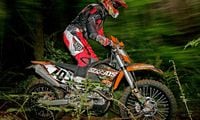
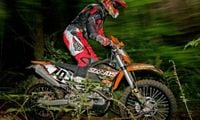

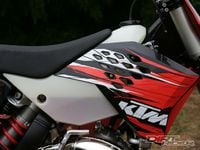
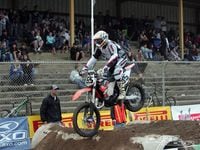
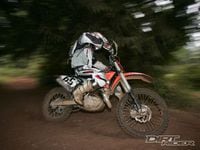
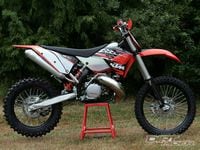
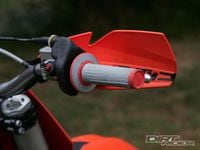
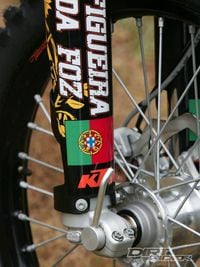
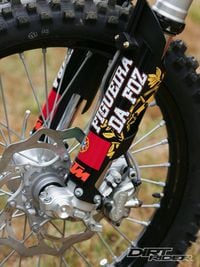
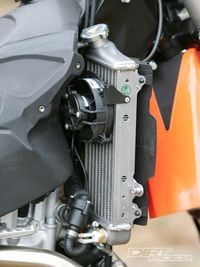
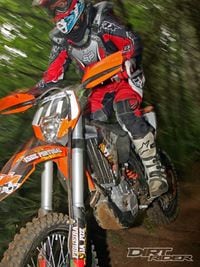
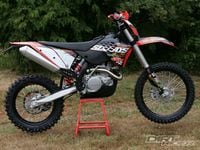
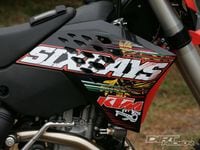

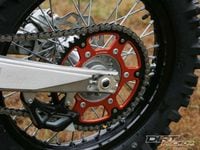
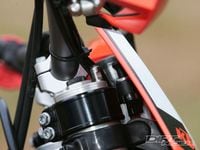
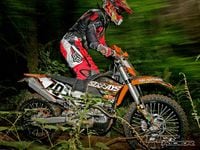
/cloudfront-us-east-1.images.arcpublishing.com/octane/T3Y7A52TXBEBJNEPGOQSVPQSPU.jpg)
/cloudfront-us-east-1.images.arcpublishing.com/octane/KY33U3WBTNFIBJFMTEF2SM7BOQ.jpg)
/cloudfront-us-east-1.images.arcpublishing.com/octane/JNPS5MGVXJC7BARVMARYQIQHXE.jpg)
/cloudfront-us-east-1.images.arcpublishing.com/octane/63N2P6SYAZDURJDO5KARQYX2J4.jpg)
/cloudfront-us-east-1.images.arcpublishing.com/octane/C72WX35SXFETTO5OVA2RWT523I.jpg)
/cloudfront-us-east-1.images.arcpublishing.com/octane/F3ER37EV2RGY5CRYFNTWE3JSF4.jpg)
/cloudfront-us-east-1.images.arcpublishing.com/octane/L65QCUR32RH2NKCUHXYHHAPDFI.jpg)
/cloudfront-us-east-1.images.arcpublishing.com/octane/VSK246VVRRDMBNQU7B2NTNY6AE.jpg)
/cloudfront-us-east-1.images.arcpublishing.com/octane/CG64RRFAYRENNAP2AA22T2LSJY.jpg)
/cloudfront-us-east-1.images.arcpublishing.com/octane/IKZSRLBWMRDORMORBXSISL4D6M.jpg)
/cloudfront-us-east-1.images.arcpublishing.com/octane/BJLVRPJSDFC3ZLPMW3LYYHMPZE.jpg)
/cloudfront-us-east-1.images.arcpublishing.com/octane/RQW2RFU4MJDYRPVFJNW362SEXU.jpg)
/cloudfront-us-east-1.images.arcpublishing.com/octane/CGQDU7HEEBBWBLF6SMXCJIW7DI.jpg)
/cloudfront-us-east-1.images.arcpublishing.com/octane/B35XXACE4ZGU5BWSEMEFUL6SN4.jpg)
/cloudfront-us-east-1.images.arcpublishing.com/octane/TDSGY4VSSRC4LP6PYXP62U236Y.jpg)
/cloudfront-us-east-1.images.arcpublishing.com/octane/4YWNAG64EZF63AQI3VL7ANERSY.jpg)
/cloudfront-us-east-1.images.arcpublishing.com/octane/QFQQG7ZZKFB5VC7C7B5PTOCJ2E.jpg)
/cloudfront-us-east-1.images.arcpublishing.com/octane/F6OD34H47ZER7KMC5RKMRWKU64.jpg)
/cloudfront-us-east-1.images.arcpublishing.com/octane/OL2BBABYPRGLLA34ONSWUVN7RQ.jpg)
/cloudfront-us-east-1.images.arcpublishing.com/octane/SKD5PT7E4RHABPEPPXAFQRPOCE.jpg)
/cloudfront-us-east-1.images.arcpublishing.com/octane/XIGZAPB55ZGTLO4QKFGTLMDHGQ.jpg)
/cloudfront-us-east-1.images.arcpublishing.com/octane/37HWZLXD45BQXJ66M6F5HCWNBI.jpg)
/cloudfront-us-east-1.images.arcpublishing.com/octane/ZX4T6QDGRVA2JIRKQGDTKD7GQY.jpg)
/cloudfront-us-east-1.images.arcpublishing.com/octane/BSZF6XDGO5FNBNRPXLO6JPFGEE.jpg)